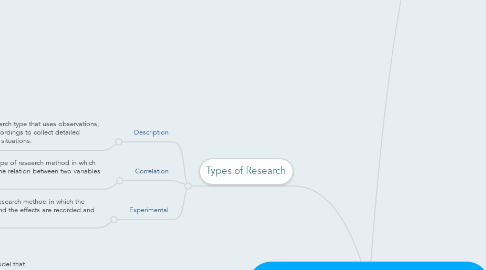
1. Types of Research
1.1. Description
1.1.1. Descriptive study is a research type that uses observations, surveys, interviews and recordings to collect detailed information about specific situations.
1.2. Correlation
1.2.1. Correlation research is a type of research method in which statistical descriptions of the relation between two variables are recorded.
1.3. Experimental
1.3.1. Experimental research is a research method in which the variables are manipulated and the effects are recorded and analyzed.
2. Types of Identity
2.1. Cultural Identity
2.1.1. Bronfenbrenner
2.1.1.1. Bronfenbrenner developed a theory based on a bioecological model that describes the cultural and social contexts involved within the development of identity. This identity involves a personal eco-system that assists in shaping an individual's identity.
2.1.2. Cultural Proficiency
2.1.2.1. Cultural Proficiency is described within stages of consciousness as cultural destruction, incapacity, blindness, pre-competence, competence, and finally, proficiency. Each stage propels an individual toward the next with new insight and understanding.
2.2. Personal Identity
2.2.1. Self-Concept
2.2.1.1. Self-Concept is the foundation of social and emotional development. Self-Concept is linked to an individual's pride within personal accomplishments.
2.2.2. Self-Esteem
2.2.2.1. Self-Esteem is an overall judgement that includes personal judgement, pride and confidence.
2.2.3. Self-Efficacy
2.2.3.1. An individual's capability to deal with a particular task
3. Types of Development
3.1. Cognitive Development
3.1.1. Nature
3.1.1.1. Piaget
3.1.1.1.1. Piaget's Cognitive Development theory argued that an individual's ability to become successful is based on the abilities they were born with. Piaget argued that an individual's IQ is not a factor of their environment but something an individual is born with.
3.1.1.2. Spearman
3.1.1.2.1. Spearman's view of Cognitive Development within Nature perspective is exemplified through his intelligence tests.
3.1.1.3. Carroll
3.1.1.3.1. Caroll's theory of Cognitive Development through the Nature perspective is represented by his belief in biological evolution and the set capabilities each individual is born with.
3.1.2. Nurture
3.1.2.1. Vygotsky
3.1.2.1.1. Vygotsky argues that Cognitive Development is dependent on the individual's environment and the influences of teachers, parents and role models.
3.1.2.2. Gardner
3.1.2.2.1. Gardner's Cognitive Development theory discusses the possibility of nurture based intelligence. Gardener's theory states that individual's are born with inclinations which can be molded and advanced.
3.1.3. Cognitive Development is understood as a gradual change in which mental processes develop into processes that are more complex and sophisticated.
3.1.4. Nature and Nurture
3.1.4.1. Brain-Based
3.1.4.1.1. Brain development is dependent on both Nature and Nurture views. Within nature, the brain is designed to develop throughout an individual's life. Nurture is important for the development of the brain as the brain needs guidance and cultivation in an effort to develop in way that allows an individual to better control their emotions, ability to focus, and further cognitive strengths.
3.1.4.2. Sternberg
3.1.4.2.1. Sternberg relates Nature and Nurture into three intelligences. Common Sense, Creativity and Academic intelligence allow individual's to pursue their strengths in an effort to compensate for their weaknesses.
3.2. Social and Emotional Development
3.2.1. Erikson
3.2.1.1. Erikson's theory explores social and emotional development as the theory promotes a rigid framework that outlines normal development.
3.2.2. Marcia
3.2.2.1. Marcia's theory deals with social and emotional development because the theory explores the process of significant life decisions. Marcia's theory acknowledges that individuals shape the personalities of one another as well as personal emotions.
3.2.3. Goleman
3.2.3.1. Goleman argues that individuals need to correlate intelligence with emotion. Goleman's theory encourages individuals to think about their emotions in an effort to better understand and control them.
3.2.4. Sywester
3.2.4.1. Sylwester believes that teachers understand their curriculum, and student development best . Social and Emotional Development result throughout adolescence and therefore it is the responsibility of the teacher to guide and cultivate the student during during this development.
3.2.5. Social and Emotional Development relate to changes over time with the personality in the ways we relate to others.
3.3. Development is understood as the change human beings undergo between conception and death. These changes remain for a long period of time.
3.4. Moral Development
3.4.1. Goleman
3.4.1.1. Goleman believes in four domains of development. Goleman argues that individuals must learn to consciously use intelligence to guide moral development as well as the other domains of development.
3.4.2. Gilligan
3.4.2.1. Gilligan's theory understands that answers to moral development bears no correct answer when it comes to teaching morals.
3.4.3. Shame, Guilt and Loneliness
3.4.3.1. Shame, Guilt and Loneliness coincide with Moral Development as these factors detail what is socially acceptable and feelings that result when social conventions are defied.
